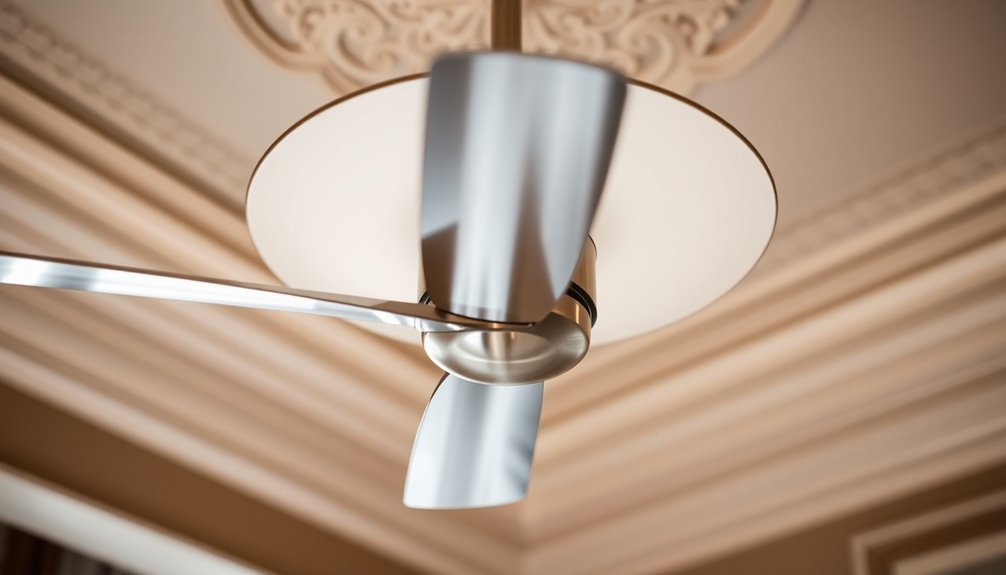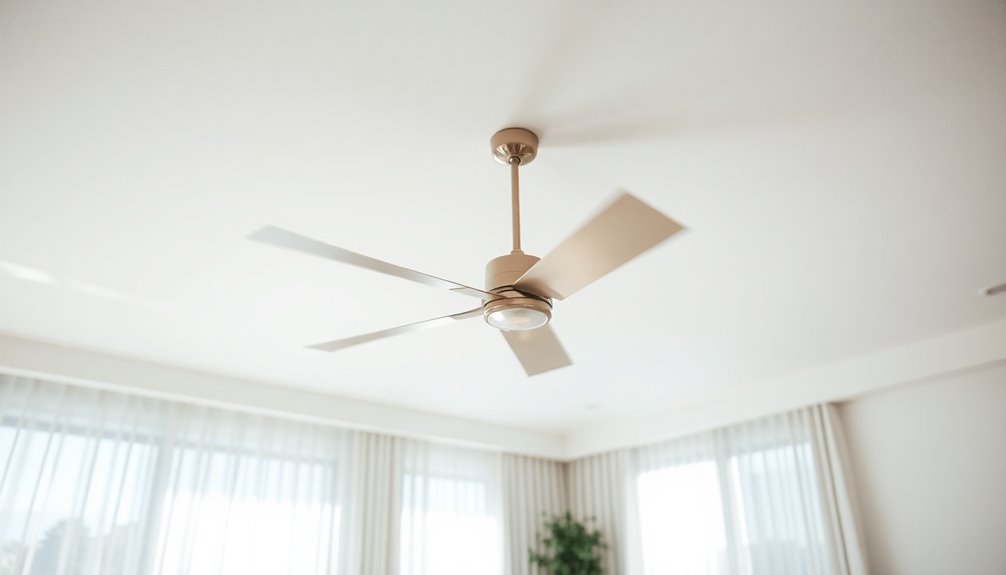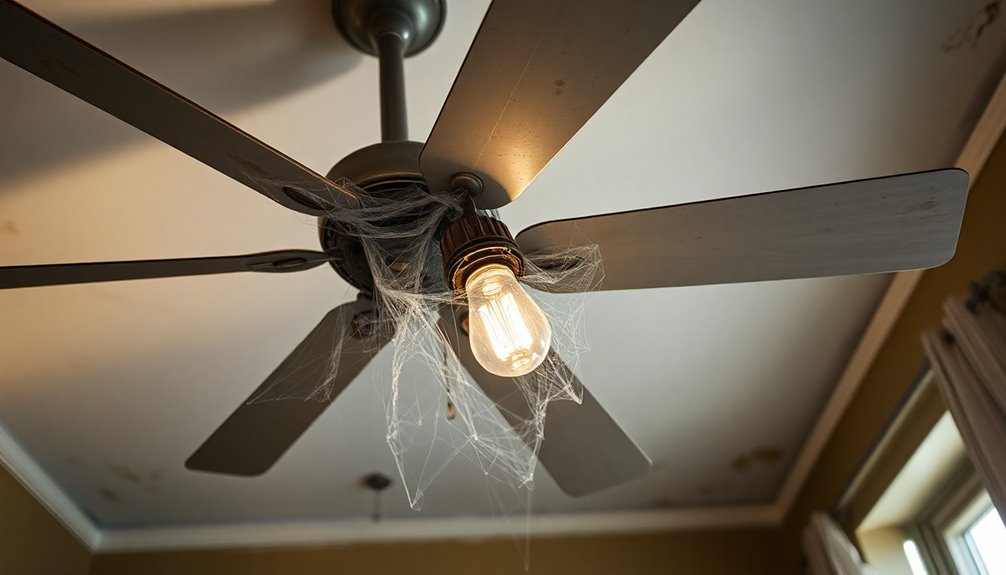A ceiling fan shouldn't wobble excessively, though a slight sway might be normal. If your fan wobbles more than that, it typically points to an imbalance that needs your attention. Common causes include loose screws, uneven blade spacing, or misaligned blades. Inspect and tighten any loose hardware to improve stability. You might also want to check for dust buildup affecting airflow. If you've tried fixing it and the wobble persists, it could be time to call in a professional to assess potential hidden issues. There's much more to explore about fixing and maintaining your fan hands-on.
Key Takeaways
- A slight wobble in a ceiling fan is common, but excessive wobbling indicates potential issues that need to be addressed.
- Proper blade alignment and weight distribution are crucial to prevent wobbling and ensure efficient operation.
- Loose screws or misaligned blades can contribute to instability and should be regularly inspected and tightened.
- Using a ceiling fan balancing kit can help correct wobble and improve overall fan performance.
- If wobbling persists after adjustments, professional servicing may be necessary to identify and fix underlying problems.
Understanding Ceiling Fan Wobble

Ceiling fan wobble is a common issue that many homeowners encounter, and understanding its causes can help you address it effectively. A wobbly ceiling fan might seem harmless, but excessive wobbling can indicate underlying problems that need your attention.
One major factor is the weight distribution of the blades; if they're uneven, it can create an imbalance. Regularly checking for loose screws is vital, as these can also contribute to the wobble.
Additionally, dust accumulation can disrupt the balance of ceiling fans. Regular cleaning helps maintain proper airflow and keeps the blades aligned, reducing wobbling.
You should also guarantee that the distance from the blades to the ceiling is maintained at 8-10 inches to optimize air circulation and minimize wobbling.
Investing in high-quality ceiling fans can make a significant difference; they typically feature better manufacturing standards that enhance stability, reducing the chances of a wobbly ceiling fan. Furthermore, maintaining proper fan alignment ensures that the fan operates quietly and efficiently, further minimizing any wobbling issues.
Common Causes of Wobbling

If your ceiling fan wobbles, it might be due to blade alignment issues or loose mounting hardware.
You'll want to check that the blades are evenly spaced and securely attached to the motor.
Addressing these common causes can help restore stability to your fan.
Blade Alignment Issues
Wobbling in ceiling fans often stems from blade alignment issues, which can disrupt airflow and create an unsettling noise.
If your fan blades aren't aligned properly, even slight variations in height or angle can lead to imbalances. To minimize wobble, it's crucial to verify that all fan blades are equal in length, width, and weight. Any discrepancies in these factors can cause uneven weight distribution, exacerbating the problem.
Here are some common steps to address blade alignment issues:
- Inspect for warped or damaged blades that may affect balance.
- Regularly check and tighten the screws securing the fan blades to the blade holder.
- Confirm proper installation by following the manufacturer's guidelines.
- Monitor the fan for any signs of imbalance, adjusting as necessary.
Taking these steps can greatly reduce wobbling and prolong the life of your ceiling fan.
By maintaining proper blade alignment and verifying all components are secure, you can enjoy a smoother airflow and a quieter operation.
Loose Mounting Hardware
Addressing loose mounting hardware is vital for maintaining a stable ceiling fan and preventing annoying wobbling. Loose mounting hardware, like screws that secure the mounting bracket or downrod, can disrupt the fan's stability, leading to a noticeable ceiling fan wobble during operation. To tackle this issue, regularly check and tighten all screws. Even slightly loose screws can compromise the fan's balance, making it essential to guarantee everything is secure.
The mounting bracket must be firmly fastened to the ceiling structure. Any movement here can introduce instability, resulting in wobbling. To reduce the likelihood of this happening, make certain your fan is installed on a fan-rated electrical box or adjustable fan brace. This proper installation helps maintain a stable mount, minimizing the risk of wobbling due to loose hardware.
Periodic maintenance is key. Inspect for loose mounting hardware regularly to prolong your fan's lifespan and enhance safety. By addressing these loose screws and guaranteeing a secure installation, you can effectively balance a ceiling fan, keeping it wobble-free and functioning smoothly for years to come.
Checking Blade Alignment

Checking the alignment of your ceiling fan blades is essential for guaranteeing smooth operation and minimizing wobble. A wobbly fan can be both annoying and a sign of underlying issues. To maintain proper fan balance, you need to verify all blades are straight and properly installed.
Here's what to take into account for effective blade alignment:
- Tighten screws: Regularly check the screws securing the blades to the blade holder. Loose screws can lead to instability.
- Measure the distance: Measure the distance from each blade to the ceiling. All blades should maintain equal spacing for maximum airflow and balance.
- Inspect connections: Regularly inspect the screws holding the blade holder to the fan flywheel. Secure connections help prevent wobbling.
- Adjust misalignments: If you find any misaligned blades, gently bend the blade holder to correct discrepancies in alignment.
Tools for Balancing Fans

When your ceiling fan starts to wobble, having the right tools at your disposal can make all the difference in restoring balance. First, you'll need a ceiling fan balancing kit, which typically includes clips and adhesive weights to correct any imbalance.
Make certain to have a ladder handy for safe access to your fan, as well as a screwdriver to tighten any loose screws that could contribute to the fan wobble.
You should also keep a level close by to check the horizontal alignment of your fan blades. Measuring the height of each blade is vital; uneven blade height can lead to instability. A measuring tape will help you guarantee proper blade spacing, which is fundamental for smooth operation.
Before you start adjusting anything, don't forget to clean the fan blades. Dust and dirt accumulation can exacerbate wobbling, so use a duster or microfiber cloth to wipe down the blades and fan motor.
With these fundamental tools for balancing fans, you'll be well-equipped to tackle any wobble and restore your ceiling fan to its best performance.
Steps to Fix Wobble

To fix a wobbling ceiling fan, start by checking for loose screws on the fan blades and mounting bracket.
Next, inspect the alignment of the blades to guarantee they're evenly spaced from the ceiling.
If the wobble continues, consider using a balancing kit to adjust the blades until it stabilizes.
Check for Loose Screws
Before diving into the details, it's crucial to guarantee your safety by turning off the power to the ceiling fan.
Once that's done, you can begin to check for loose screws, which are often the culprits behind a wobbling ceiling fan.
Start by using a screwdriver to tighten all screws securing the fan blades to the blade holders. Loose screws here can disrupt the fan's stability and create an unbalanced spin.
Next, inspect the screws holding the blade holders to the fan flywheel. Verify they're tightly secured, as this will help maintain the balance and prevent further wobbling.
It's also wise to regularly check the tightness of all screws, including those on the mounting bracket and downrod. This proactive step can greatly enhance the ceiling fan's performance and longevity.
If you find any loose screws, retightening them can dramatically reduce or eliminate the wobbling issue.
- Turn off the power first
- Use a screwdriver for inspection
- Tighten screws on blades and holders
- Regularly check all screw tightness
Inspect Blade Alignment
Guaranteeing proper blade alignment is crucial for a smoothly operating ceiling fan. Start by inspecting each blade to confirm they're straight and securely attached. Check the tightness of the screws on both the blades and their holders; loose screws can lead to wobbling.
Next, measure the distance from each blade to the ceiling. Ideally, all blades should be spaced 8-10 inches away for best airflow. If you notice any discrepancies, it could indicate misalignment that needs correcting.
Use a level to check for horizontal alignment; if any blades dip or rise, they'll disrupt the fan's balance. Also, inspect the blades for any warping or damage. Even slight warping can greatly affect stability and contribute to wobbling.
If you find misaligned blades, gently bend the blade holder or tighten the screws to achieve uniform spacing and alignment.
Taking these steps will help guarantee your ceiling fan operates smoothly and efficiently, reducing any wobbling issues you may experience. Regular maintenance of blade alignment can extend the lifespan of your fan and enhance its performance.
Use Balancing Kit
After checking the blade alignment, you might still notice some wobbling in your ceiling fan. In this case, using a balancing kit can help you achieve the best performance.
Here's how to get started:
- Attach a plastic clip to the end of one blade and run the fan to see if the wobbling persists.
- Move the clip along the blade's edge to find the best position that minimizes wobbling.
- If you identify a problematic blade, apply adhesive weights to its center. Don't forget to remove the clip after securing the weight!
- If adjustments are still needed, try adding more weights to the blade tips for better balance.
Continue to rotate the blades and test the fan after each adjustment.
By following these steps, you'll guarantee that all blades are aligned and balanced, reducing any wobbling ceiling issues.
Importance of Regular Maintenance

Regular maintenance is key to keeping your ceiling fan running smoothly and wobble-free. If your ceiling fan is wobbling, this might indicate that it's time to check various components. Start by ensuring all screws and fasteners are securely tightened. Loose parts can lead to instability over time, causing that annoying wobble.
Cleaning the fan blades frequently is also essential. Dust accumulation can affect balance, resulting in uneven weight distribution that contributes to wobbling. Make it a habit to inspect blade alignment and condition regularly. Early detection of any warping or damage can prevent minor issues from escalating into significant problems.
Don't forget to check the installation height and clearance from nearby objects. Proper airflow is vital for a wobble-free operation.
Scheduling professional servicing can offer deeper insights into persistent wobbling issues. Experts can help identify underlying problems you mightn't notice, ensuring your fan operates efficiently and safely.
When to Seek Professional Help

If your ceiling fan continues to wobble despite your best DIY efforts, it's time to contemplate calling in a professional. A wobbly fan can indicate underlying issues that require expert assessment.
Professionals can accurately evaluate the installation and guarantee the fan is securely mounted. If you hear unusual noises or notice significant wobbling during operation, it's essential to reach out to a skilled technician to prevent potential safety hazards.
Here are some signs that you should seek professional help:
- Persistent wobbling after DIY balancing attempts
- Unusual noises during operation
- Visible signs of blade warping or damage
- Frequent need for maintenance or repairs
Frequently Asked Questions
Is It OK if a Ceiling Fan Wobbles a Little?
It's generally okay if your ceiling fan wobbles a little, especially if it's a lower-quality model. A slight wobble at high speeds is common, but you should keep an eye on it.
If the wobbling becomes excessive, it's time to check for loose screws or imbalanced blades.
Regular maintenance, like cleaning and blade alignment, can help minimize issues and guarantee your fan runs smoothly without causing damage.
How to Know if a Ceiling Fan Will Fall?
You can't ignore the unsettling feeling when your ceiling fan wobbles.
To know if it's at risk of falling, inspect the mounting; loose screws can spell disaster. Look for warped blades or signs of wear. Confirm it's securely attached to a fan-rated electrical box, and maintain at least 30 inches of clearance from objects.
Regularly check for tightness and stability—catching issues early could mean the difference between a breeze and a catastrophe.
Will a Wobbling Fan Fall?
A wobbling fan can fall if the imbalance is severe. You should check the fan's mounting and verify all screws are tight.
If the wobble persists, it's best to stop using the fan until you address the issue. Regular maintenance, like checking blade alignment and securing fasteners, helps prevent accidents.
Are Ceiling Fans Supposed to Swing?
Ceiling fans aren't supposed to swing excessively. While a slight wobble can happen at high speeds, noticeable swinging usually indicates an issue.
If you notice your fan swinging, it's time to check the alignment of the blades, guarantee the mounting bracket is secure, and look for any loose screws or warped blades.
Regular maintenance can prevent these problems and keep your fan operating smoothly, assuring comfort in your space.
Conclusion
To sum up, while a slight wobble in your ceiling fan might seem normal, it often signals an underlying issue that needs attention. Coincidentally, addressing these problems not only enhances your fan's performance but also extends its lifespan. By regularly checking for blade alignment and maintaining your fan, you can enjoy a quieter, more efficient operation. So, take a moment to inspect your fan—who knows, your quick fix might lead to a surprisingly peaceful evening!









